After you have taken your pictures, now it’s time to get your film developed. There are several places you can develop your film . If you’ve decided to mail your film to be processed to an online lab, you may not know what steps to take to purchase inexpensive shipping or how ensure your film arrives safely.
To safely send film through the mail for development, put it in a clear Ziplock bag, in a padded envelope or tiny cardboard box, and use USPS first class package service since it provides tracking and costs between $4.45 – $7.65 for 1 – 10 rolls of 35mm or medium format (120) film or 1 – 2 disposable cameras.
Keep reading to learn if it is save to ship undeveloped film through the mail, tips for mailing film for development, how much different film types weight, why you would want to ship film through the mail using USPS postal service Priority shipping, where to ship film for development, and what it costs to mail 10 or more rolls of 35mm and medium format (120) film or more disposable cameras.
Is it Safe to Ship Undeveloped Film in the Mail?
Yes, it is safe to send mail through the mail and you won’t have any trouble sending undeveloped (or unexposed film) to a film lab for processing. Remember to not mail film by placing it into a hot mailbox as it will degrade the film. However, the most common concerns are that the mail service will lose your package and that x-rays may damage your film in transit.
Concern #1: Mail Carrier Losing Film
One of the main concerns that people have with shipping film is the carrier may lose the film. This is a big problem, as the memories and moments on your film are irreplaceable. But there are a few things that you can do to avoid this:
- Clearly Label The Package. Make sure to clearly label your package with the address and sender’s address. I recommend putting packaging tape over anything that could be messed up by water (except for bar codes). In the rare cases where there is a problem, the film will be returned to you.
- Get tracking. If you choose a service like USPS first class package service
 or USPS priority mail, tracking will be included so you’ll have the peace of mind that comes with knowing that your film has safely arrived at the film processing lab. If something does happen, you’ll have some recourse. Also, priority shipping includes up to $50 in insurance of the contents of the package and you can insure it for more if necessary.
or USPS priority mail, tracking will be included so you’ll have the peace of mind that comes with knowing that your film has safely arrived at the film processing lab. If something does happen, you’ll have some recourse. Also, priority shipping includes up to $50 in insurance of the contents of the package and you can insure it for more if necessary.
Concern #2: X-Rays Scanning Ruining Film When Mailing
Another common concern is that the film will be put through an X-ray when shipping the film and it will be ruined. If you are sending your film domestically USPS, this won’t be a serious concern. It’s rare for a carrier like USPS to scan your package using X-Rays for security reasons unless it is going to or through larger cities or coming into the country. However, the scan shouldn’t harm film that has a film speed less than 800 ISO (FYI, Polaroid and Instax film are both rated at 800 ISO). If you are shipping film over 800 ISO, than I recommend using USPS Priority Mail and telling the post office when buying postage or dropping it off. The USPS website also states to contact your local Post Office if have additional questions about the X-Raying of items.
if have additional questions about the X-Raying of items.
After speaking someone at my local post office, they recommended asking for and using a “Handle With Care” sticker at your Post Office and writing “Photographic Film – Do Not X-ray” on the outside of the package.
NOTE: According to the USPS website , do not just write “DO NOT X-RAY” on your film package since it “will not forgo the X-Raying of a mailpiece, as it may result in the item being suspicious” and therefore more likely to be scanned.
, do not just write “DO NOT X-RAY” on your film package since it “will not forgo the X-Raying of a mailpiece, as it may result in the item being suspicious” and therefore more likely to be scanned.
For more information about traveling with film, see this article about flying confidently with film .
.
How Do I Mail a Roll of Film?
When it comes to shipping a roll of film for development, it is much like shipping anything else through the mail. Each online film lab ordering system will differ slightly but the process for shipping film but in general, the steps for shipping a roll of film for development are:
will differ slightly but the process for shipping film but in general, the steps for shipping a roll of film for development are:
- Go the webpage of the online lab. Here is a list of 14 online labs compared by price
 . Click on their webpage for developing film.
. Click on their webpage for developing film. - Choose the type of film you want to process from all of the options
- Use the menu to choose scanning options. Some labs let you choose if you want to scan your negatives or not. If you are scanning your own negatives, then you can save a little money here. You can also choose if you want prints as well and other options. (For example, if you want to pull or push your film
 or not have your negatives cut)
or not have your negatives cut) - Enter the number of rolls you have to process and click “Add to Cart” or a similar button to add your selection to the cart.
- Click “Checkout” or a similar button when you are ready to complete your order by following the steps.
- Purchase postage to the film processing lab, if necessary. I recommend using USPS First Class Package Service for the cheapest shipping rate which is between $4.45 – $7.50 depending on the number of rolls and distance traveling to facility). You can also use the USPS postage calculator
 to figure out the best price (also see below for more info about the cost of mailing film).
to figure out the best price (also see below for more info about the cost of mailing film). - Attach shipping label to a padded mailing envelope or box (don’t use a paper envelope). You can find padded envelopes at USPS post office.
- Insert the form, payment, film (placed in a clear, plastic Ziplock bag for protection like in the image below). Make sure to tape the package closed before dropping it off at a mailbox or the post office
- Drop off the package at your local post office or mailbox. However, don’t put your film in a hot mailbox from direct sun as this will degrade your image.
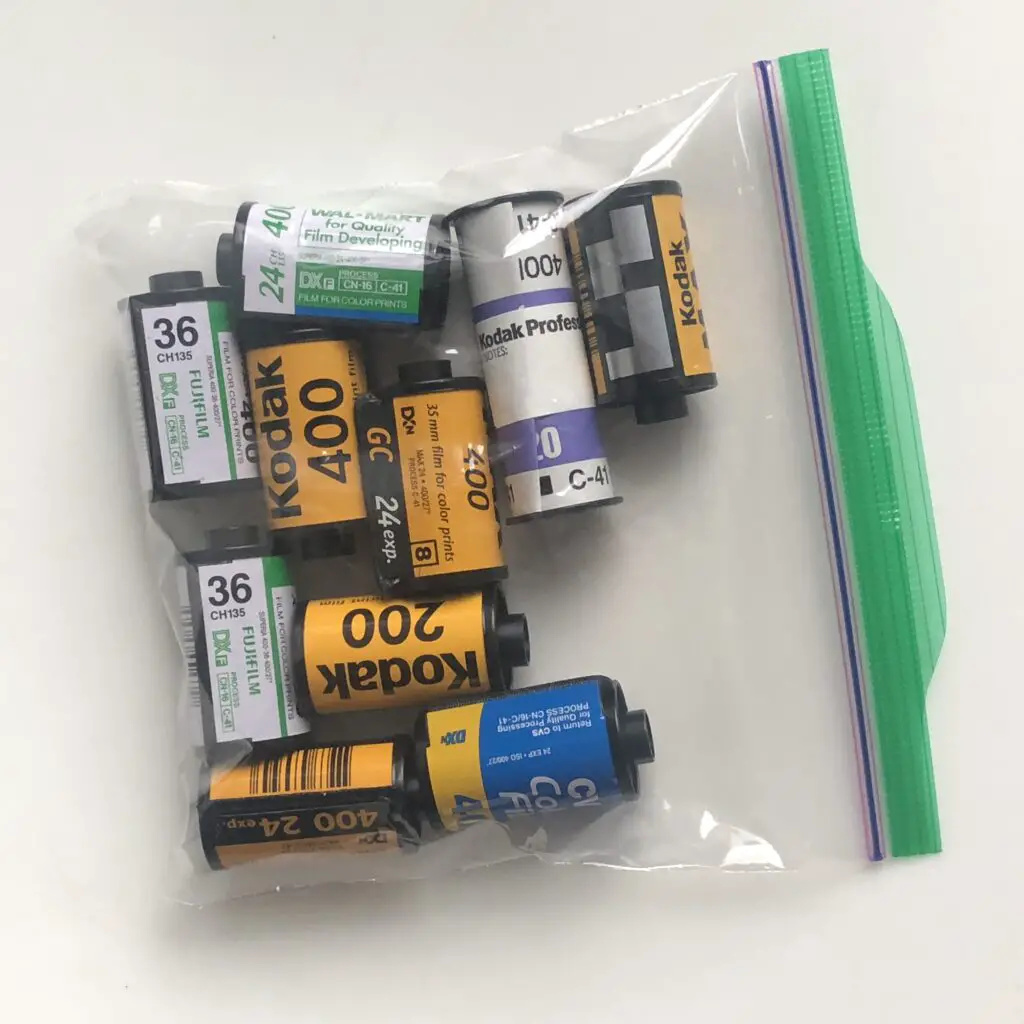
Below are also, a few tips to follow that will make sure your film arrives to the processing lab or back to you safely:
- Put film in a clear, plastic Ziplock-style bag. Make sure that you pack the film rolls carefully, using a clear, plastic Ziplock bag. A clear, plastic bag will protect your film from water damage and keep your film from falling out if your padded envelope gets torn during transit.
- Use a padded envelope to ship film. Do not use a bag, paper envelope, or bubble style mailer when sending mail to be processed, since these can be easily torn and don’t offer any protection. Only use a thick, padded envelope when mailing in small orders of film for development since it doesn’t easily tear and put your film in a clear, plastic bag before placing it into the padded envelope.
- Use a small box for a larger order. If you are shipping a large order of film to be processed, then I suggest that you use a small cardboard box along with some padding using newspaper or plastic grocery bags. Just like with a padded envelope, you should also put your film in clear, plastic Ziplock bags when using a box to keep the film together and prevent them from falling out.
- Label the canisters. The people who work in a photo processing center are skilled professionals, but they aren’t mind readers. They don’t know whether a roll should be pushed or pulled and or how many stops so it’s important to label your film canisters accordingly. It can also help to label the rolls in the order in which they were shot. This will help ensure a consistent look across all your pictures.
- Use a proven carrier. I recommend using USPS when shipping film to the processing lab in the US. I’ve used them before and I had no problem with my film reaching its destination. Whatever carrier you use, I suggest dropping off your film at the post office or carrier location. You may need to do this anyway to purchasing postage, but if you purchase the label and print the mailing label at home, dropping it off will will give you a piece of mind.
- Save Money on Shipping. If you are shipping between 1 – 10 rolls of film, then I suggest using USPS First Class Package Service
 which is about 10 rolls of 35mm or medium format film in a clear plastic bag), which will cost between $4.50 – $7.65 to mail depending on it’s destination. If you are mailing more than 10 rolls of film (which will weigh more than 13 oz or 368.5 g), than I suggest using a flat rate small-sized box, which will cost $9.45 or a padded flat rate envelope for $9.65, no matter how far and up to 70 lbs (31.7 kg).
which is about 10 rolls of 35mm or medium format film in a clear plastic bag), which will cost between $4.50 – $7.65 to mail depending on it’s destination. If you are mailing more than 10 rolls of film (which will weigh more than 13 oz or 368.5 g), than I suggest using a flat rate small-sized box, which will cost $9.45 or a padded flat rate envelope for $9.65, no matter how far and up to 70 lbs (31.7 kg).
- Be Aware of Hot Mailboxes and Drop Off Your Film at the Post Office Instead. Be aware that film is susceptible to heat and humidity, especially color film. So, when mailing film be careful of mailboxes in direct sunlight as it can be so hot in the mailbox that the film can start to degrade. For this reason it is best to drop off your film at the post office.
How Much Does It Cost to Mail Film?
Some online film developers, like TheDarkroom.com and OldSchoolFilmLab.com offer free shipping
offer free shipping  to their lab for development through their websige, but if you choose an online lab that is less expensive but doesn’t offer free shipping to their facility, like Dwayne’sPhoto.com, you will need a way to get film to the lab.
to their lab for development through their websige, but if you choose an online lab that is less expensive but doesn’t offer free shipping to their facility, like Dwayne’sPhoto.com, you will need a way to get film to the lab.
When determining the cost of mailing film, the size and weight of the package makes the most difference. You can use the USPS online postage calculator  to help determine the best price for your shipment but, in general, the cheapest way to mail film is by using USPS First Class Package Service. This service cost is based the following variables:
to help determine the best price for your shipment but, in general, the cheapest way to mail film is by using USPS First Class Package Service. This service cost is based the following variables:
- Type of Mailing: First Class, Priority, Priority Flat Rate, etc
- Distance Traveled: The further it travels the more it costs to ship
- Weight: For retail, the has to be less than 13 oz (or 368.5 g) and commercial it needs to be no more than 16 oz (or 0.45 kg)
- Size and Shape of the Package: (maximum size is no more than 108 inches in length and girth combined.
- How postage is paid: (at the post office vs if the label is bought online and printed)
- Package Shipping Time: It costs more to ship faster than 2 – 5 business days of estimated shipping time for USPS first class package service. For example, Priority Mail guaranteed 2 – 3 day arrival and Priority Mail Express goes from next day – 2 days by 6 pm but both cost much more than the First Class Package Service and is best for packages that weigh between 2 – 70 lbs.
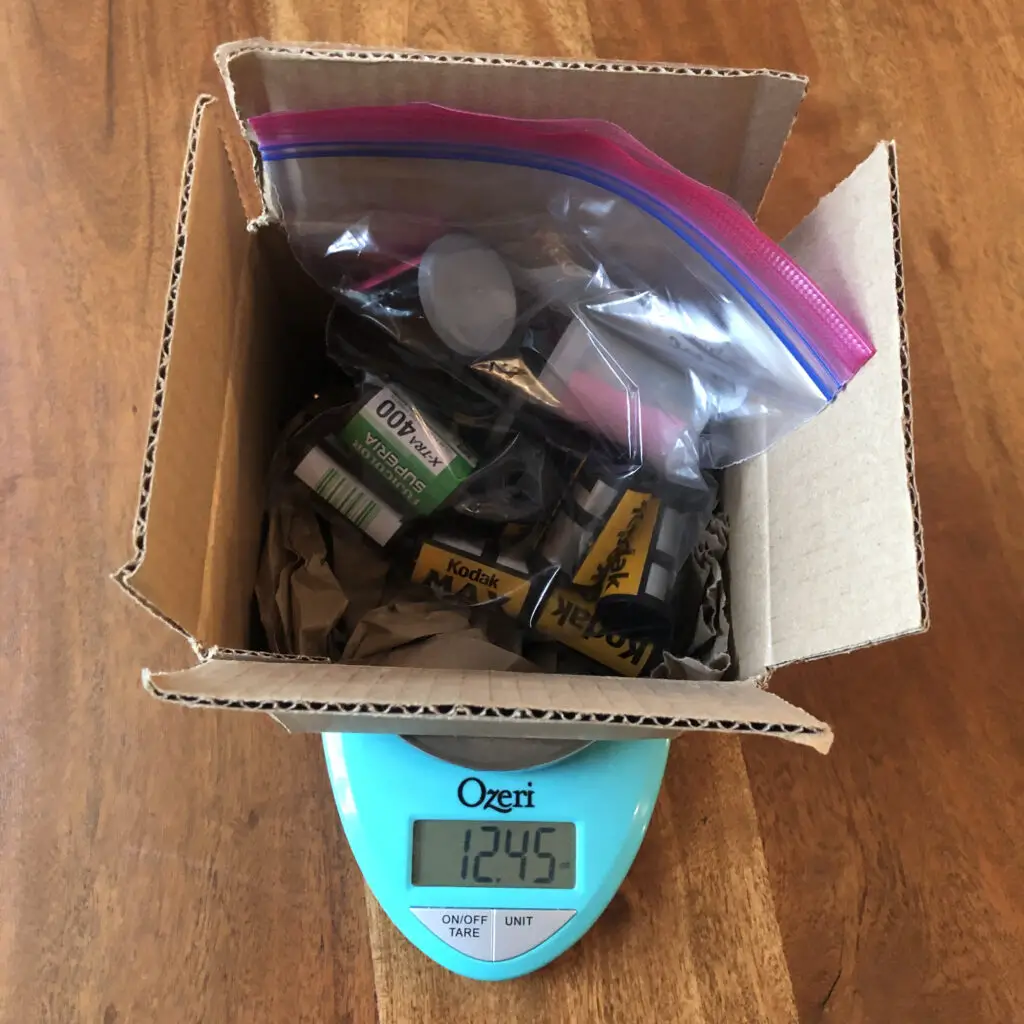
Mailing 1 – 13 Rolls of Film
If you are sending 1 – 10 rolls of film, I recommend using USPS First Class Package Service , which is one of the least expensive options and includes tracking for free in case your package is lost.
, which is one of the least expensive options and includes tracking for free in case your package is lost.
A large, padded envelope that measures 7.5 x 10.5 inches and weighs around 2.1 oz (or 59.5 g) using the USPS First Class Package Service which has a max weight of 13 oz (or 368.5 g) will hold about about 13 rolls of 35mm or medium format (120mm) film in a clear plastic bag (which together weighs around 11.35 oz or 321.7 g) and will cost between $4.50 – $7.65 to mail depending on it’s destination.
A small, cardboard box that weighs 2.65 oz (or 76 g) fit 13 rolls of 35mm film and medium format (120mm) before reaching the USPS First Class Package Service maximum weight limit of 13 oz (or 368.5 g).
Mailing More Than 13 Rolls of Film
If you want to send more than 13 film rolls of film (which will weigh over 13 oz or 368.5 g), I recommend using USPS Priority Mail instead of USPS First Class Package Service. USPS Priority mail comes with free tracking and higher insurance, and is flat fee no matter the distance and up to 70 lbs (31.7 kg). The list below explains the cost of each option, size of each, and how many rolls of film they will hold.
- A padded USPS priority mail flat rate envelope provided for free by the USPS post office will cost $9.65 (before tax) and hold about 14 rolls of 35mm or medium format (120mm) film
- A USPS priority mail small flat rate box provided for free by the post office and measures 8-5/8″ x 5-3/8″ x 1-5/8 will cost $9.45 (before tax) and hold around 20 rolls of 35mm or medium format (120mm) film
- A USPS priority mail medium flat rate box provided for free at the USPS post office comes in two sizes and measures 13-5/8″ x 11-7/8″ x 3-3/8″ or 11″ x 8-1/2″ x 5-1/2″ will cost $16.10 (before tax) and hold around 40 rolls of 35mm or medium format (120mm) film
- A USPS priority mail large flat rate box provided for free by the USPS post office measures 23-11/16″ x 11-3/4″ x 3″ or 12″ x 12″ x 5-1/2″ will cost $21.50 (before tax) and hold more than 60 rolls of 35mm or medium format (120mm) film.
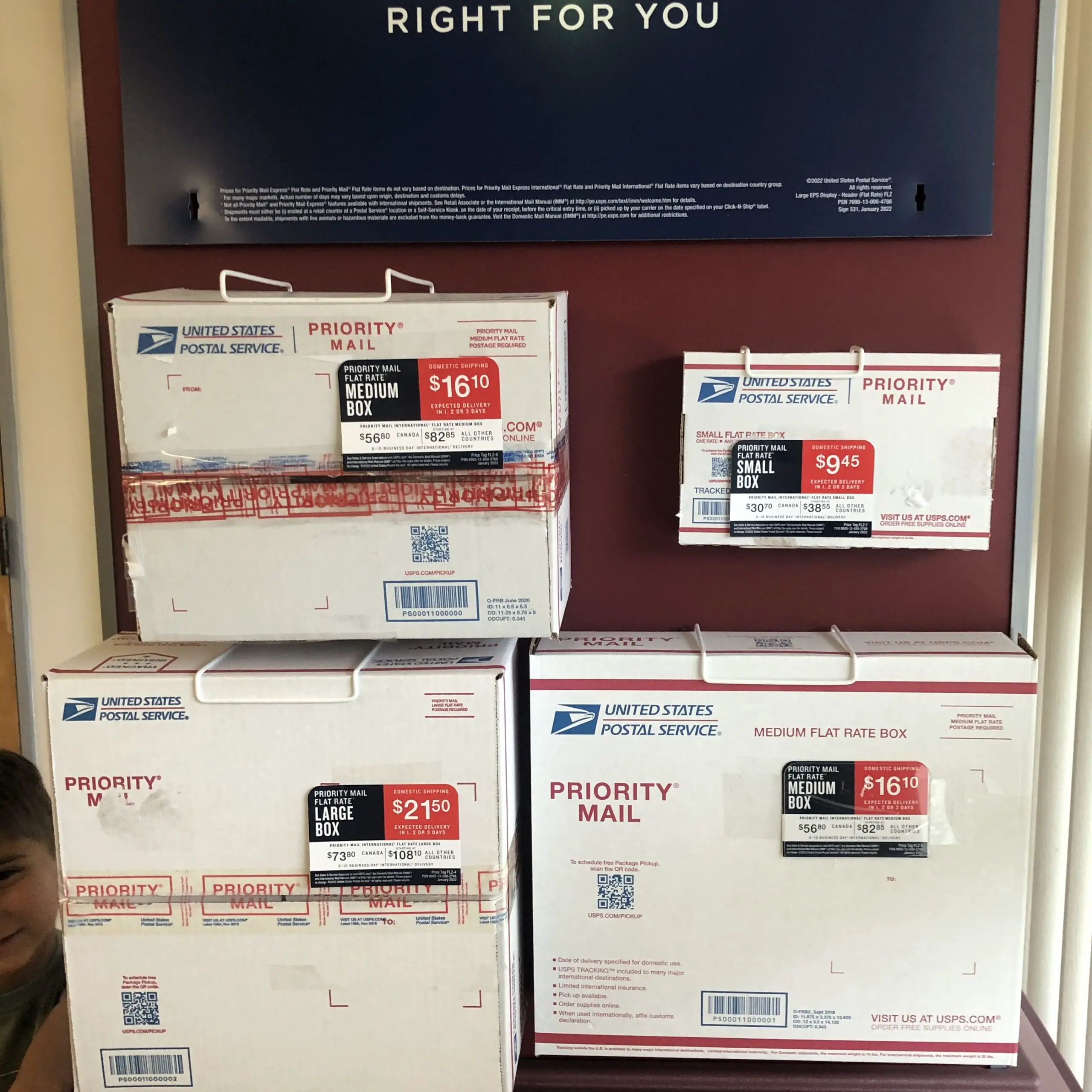
Mailing Disposable Cameras
Disposable cameras weigh much more than rolls of film (4.10 oz .80 oz.). So if you are mailing 2 or less disposable cameras to be developed than I suggest using USPS First Class Package Service to mail your disposable film cameras in a clear, plastic bag with a 5 x 7 inch padded envelope, which will cost between $4.50 – $7.65 to mail depending on it’s destination.
However, if you want to send more than 2 disposable cameras they will will weigh over the USPS First Class Package weight maximum of 13 oz or 368.5 g, so I recommend using USPS Priority Mail instead of USPS First Class Package Service. USPS Priority mail comes with free tracking and higher insurance, and is flat fee no matter the distance and up to 70 pounds (31.7 kg).
- A padded USPS priority mail flat rate envelope provided for free by the USPS post office will cost $9.65 (before tax) and will hold at least 4 disposable film cameras.
- A USPS priority mail small flat rate box provided for free by the post office and measures 8-5/8″ x 5-3/8″ x 1-5/8 will cost $9.45 (before tax) and will hold around 3 disposable film cameras.
- A USPS priority mail medium flat rate box provided for free at the USPS post office comes in two sizes and measures 13-5/8″ x 11-7/8″ x 3-3/8″ or 11″ x 8-1/2″ x 5-1/2″ will cost $16.10 (before tax). The larger box will hold about 15 disposable film cameras.
- A USPS priority mail large flat rate box provided for free by the USPS post office measures 23-11/16″ x 11-3/4″ x 3″ or 12″ x 12″ x 5-1/2″ will cost $21.50 (before tax) and will hold at least 25 disposable film cameras.
Where Can I Send Undeveloped Film?
Check prices and send them to other film developing articles. Also, mention drugstores as an option.
It’s also important to consider the costs associated with developing your film. This will vary depending on the the place. Though there are lots of options some of the best options items are:
1. Dwayne’s Photo
At the time of writing, DwaynesPhoto.com charges around $14 before tax ($6 for development + $3 for the standard resolution scans + $5 and $.50 for additional roles for return shipping – depending on your location and how many rolls you had developed) to develop one roll of 35mm, medium format, or disposable / single-use camera color film. The cost for 35mm and medium format black and white film processing goes to $15 ($7 for development + $3 for the standard resolution scans + $5 and $.50 for additional rolls for return shipping – depending on your location and how many rolls you had developed). If you prefer the higher level resolution of scanning, add $4. Dwayne’s Photo does not offer free shipping to or from the lab so that is why I included the price to the overall cost.
charges around $14 before tax ($6 for development + $3 for the standard resolution scans + $5 and $.50 for additional roles for return shipping – depending on your location and how many rolls you had developed) to develop one roll of 35mm, medium format, or disposable / single-use camera color film. The cost for 35mm and medium format black and white film processing goes to $15 ($7 for development + $3 for the standard resolution scans + $5 and $.50 for additional rolls for return shipping – depending on your location and how many rolls you had developed). If you prefer the higher level resolution of scanning, add $4. Dwayne’s Photo does not offer free shipping to or from the lab so that is why I included the price to the overall cost.
2. Citizen’s Photo
At the time of writing, CitizensPhoto.com charges around $17 before tax ($5 for development of the 1st roll and $4.50 for additional rolls + $6 for the medium resolution scans (lowest available) + around $6 for return shipping – depending on your location and how many rolls you had developed). for color 35mm film and disposable / single use cameras. The cost for 35mm and medium format black and white film processing is only a dollar more at $18 (before tax). If you prefer the higher level resolution of scanning, add $2.50. Also, note that CitizensPhoto.com does not offer free shipping to or from the lab so that is why I added this to the overall cost.
charges around $17 before tax ($5 for development of the 1st roll and $4.50 for additional rolls + $6 for the medium resolution scans (lowest available) + around $6 for return shipping – depending on your location and how many rolls you had developed). for color 35mm film and disposable / single use cameras. The cost for 35mm and medium format black and white film processing is only a dollar more at $18 (before tax). If you prefer the higher level resolution of scanning, add $2.50. Also, note that CitizensPhoto.com does not offer free shipping to or from the lab so that is why I added this to the overall cost.
3. The Darkroom
At the time of writing, The Darkroom,com charges around $17.95 before tax (including $5.95 for return shipping) per roll of color or black & white 35mm film including “standard” sized scans and a digital web gallery to view and download your images. TheDarkroom.com will also develop disposable or single use film cameras for about $11 without scans or $15 with standard-sized scans (included), $18 with enhanced scans, or $23 with the largest scans. TheDarkroom.com also provides a free shipping label
charges around $17.95 before tax (including $5.95 for return shipping) per roll of color or black & white 35mm film including “standard” sized scans and a digital web gallery to view and download your images. TheDarkroom.com will also develop disposable or single use film cameras for about $11 without scans or $15 with standard-sized scans (included), $18 with enhanced scans, or $23 with the largest scans. TheDarkroom.com also provides a free shipping label to ship your film to their facility so you save on shipping to the facility.
to ship your film to their facility so you save on shipping to the facility.
4. Richard Photo Lab
At the time of this writing, Richard Photo Lab charges $21.85 ($8 for development + $7 for Universal quality scans (the middle level) + $6.85 for USPS first class shipping to TN) to develop one roll of color or black and white 35mm or medium format film with shipping (without tax). If you get the lowest scan the price drops to $18.85. Richard Photo Lab will also develop disposable or single use cameras at the time of writing for $9.49 + $6.85 for return shipping without scans or $14 with web-sized scans, $3 more with universal scans ($17), or $8 more with the largest scans ($22).
charges $21.85 ($8 for development + $7 for Universal quality scans (the middle level) + $6.85 for USPS first class shipping to TN) to develop one roll of color or black and white 35mm or medium format film with shipping (without tax). If you get the lowest scan the price drops to $18.85. Richard Photo Lab will also develop disposable or single use cameras at the time of writing for $9.49 + $6.85 for return shipping without scans or $14 with web-sized scans, $3 more with universal scans ($17), or $8 more with the largest scans ($22).
At Richard Photo Lab, you can purchase a shipping label for your film to print out and attach to your packaging to send in film on their webpage. The cheapest option is $11.95 (UPS ground and not for international packages).
It should be noted that there are many other options for developing film by mail . When choosing which one you want to use, consider additional costs. For example, you might need to pay for your developed photos to be shipped to the facility as well as shipping for your negatives back.
. When choosing which one you want to use, consider additional costs. For example, you might need to pay for your developed photos to be shipped to the facility as well as shipping for your negatives back.
How Much Does a Roll of Film Weigh?
A roll of film can weigh between 0.65 oz (18.4 g) and 4.10 oz (116 g) depending on the film format, manufacture, and the number of exposures (24 – 36) with 35mm film rolls weighing the least amount and disposable cameras with a built-in flash weighing the most.
35mm
A roll of 35mm weighs between 0.65 oz (18.4 g) to 0.80 oz (22.6 g) depending on the type of film (color or black & white), who makes it, and how many exposures the film is capable of holding (24 – 36 exposures).
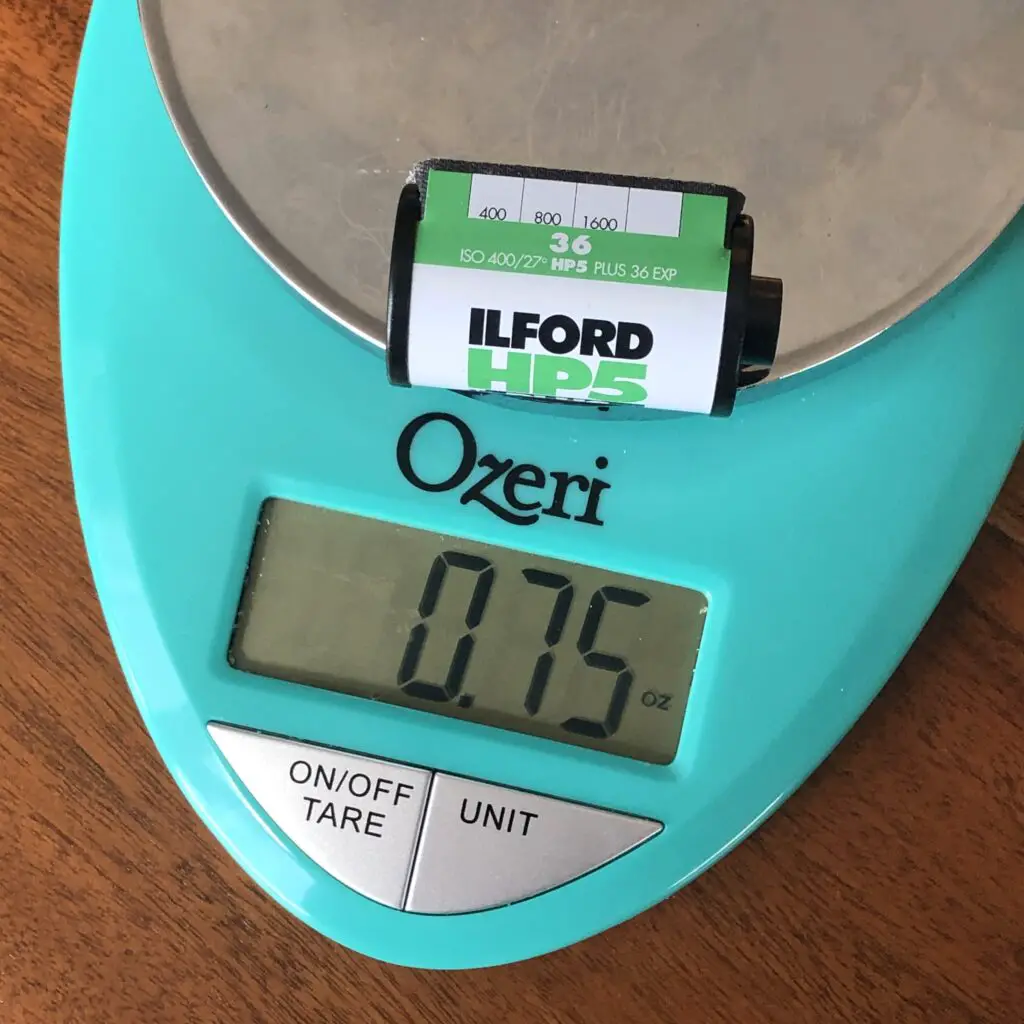
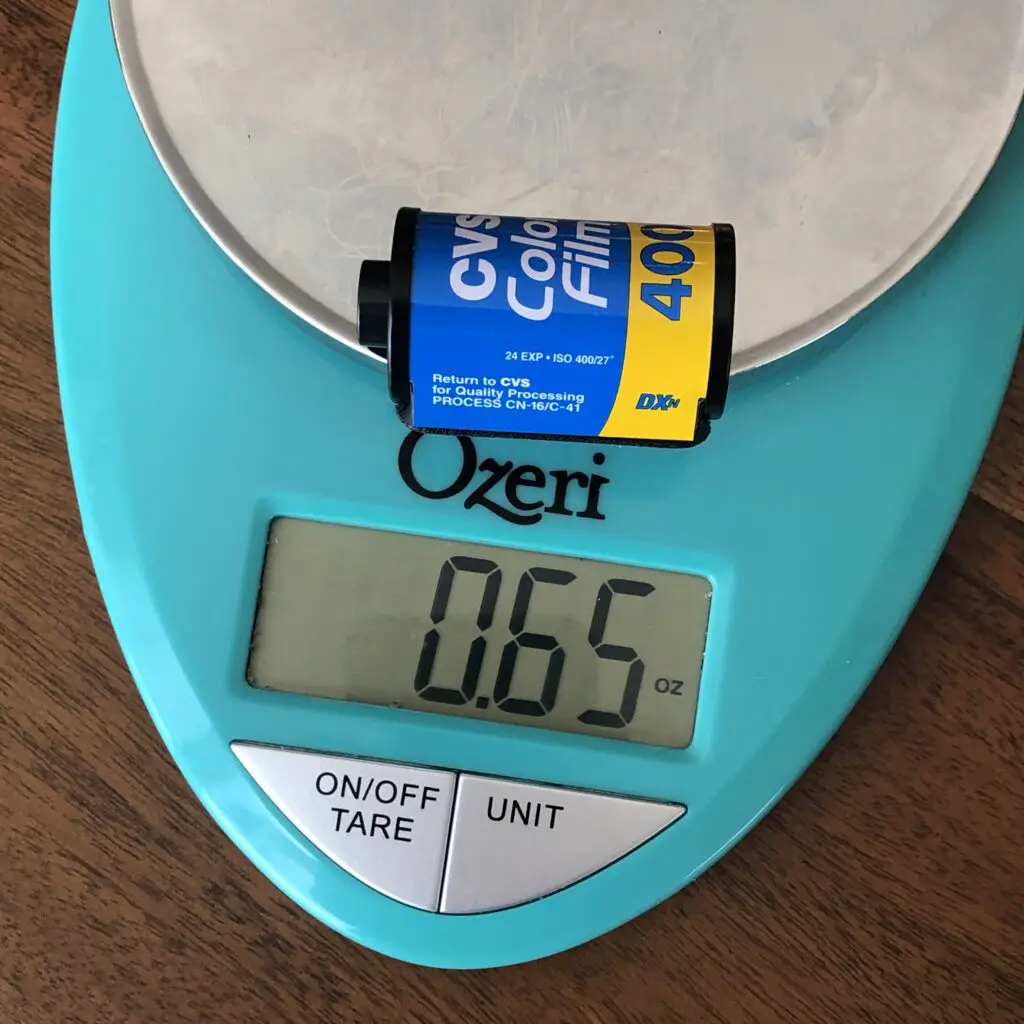
Medium Format (120mm) film
A roll of color Medium format (120mm) film weighs around 0.80 oz (22.6 g) but can also vary slightly depending on the manufacturer and type of film.
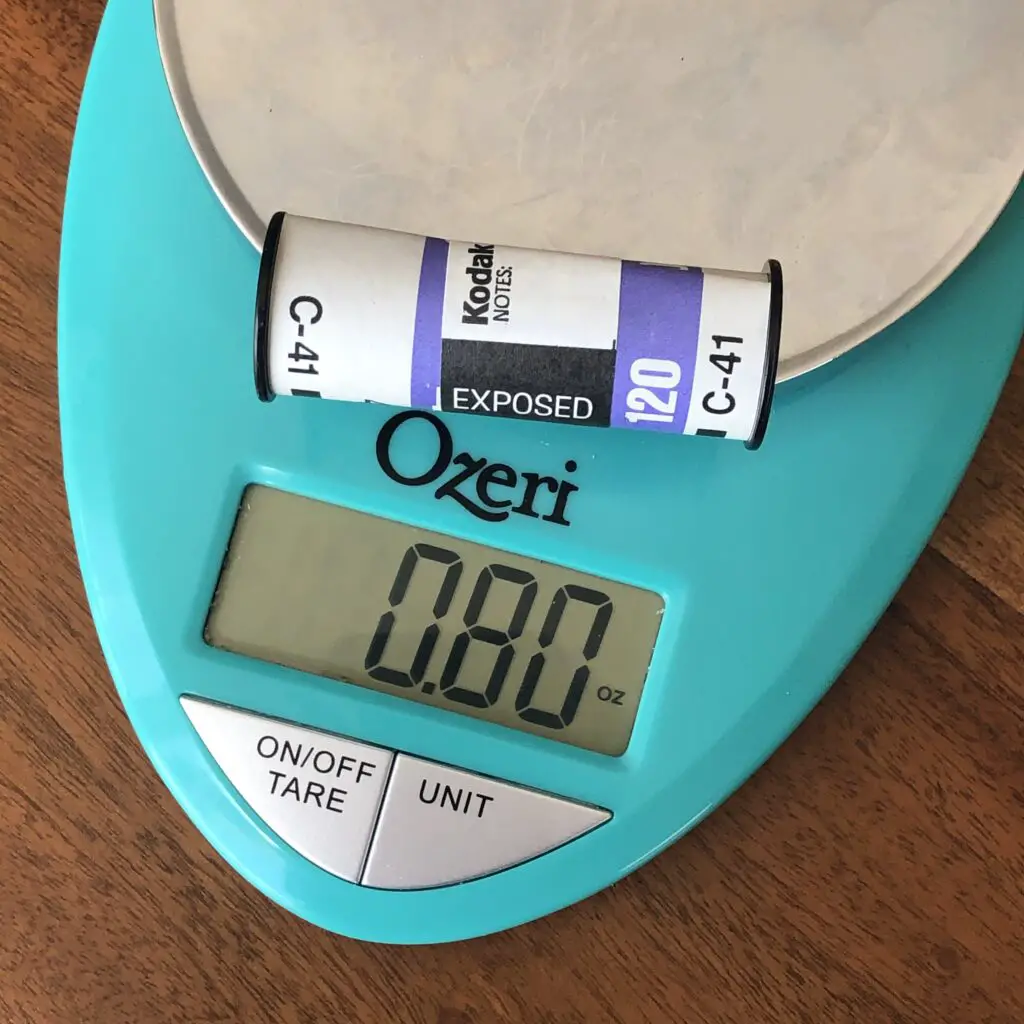
Disposable Cameras
A regular disposable film camera with 27 exposures weighs around 4.10 oz (116 g) but can also vary depending on the manufacturer, how many exposures, if it has a flash or not, or if the camera is waterproof. For example, the Fujifilm Quick Snap Waterproof disposable camera weighs around 6 oz. (170 g) because of the plastic housing and the Kodak Sport Waterproof Disposable Camera weighs 5.92 (167.8 g).
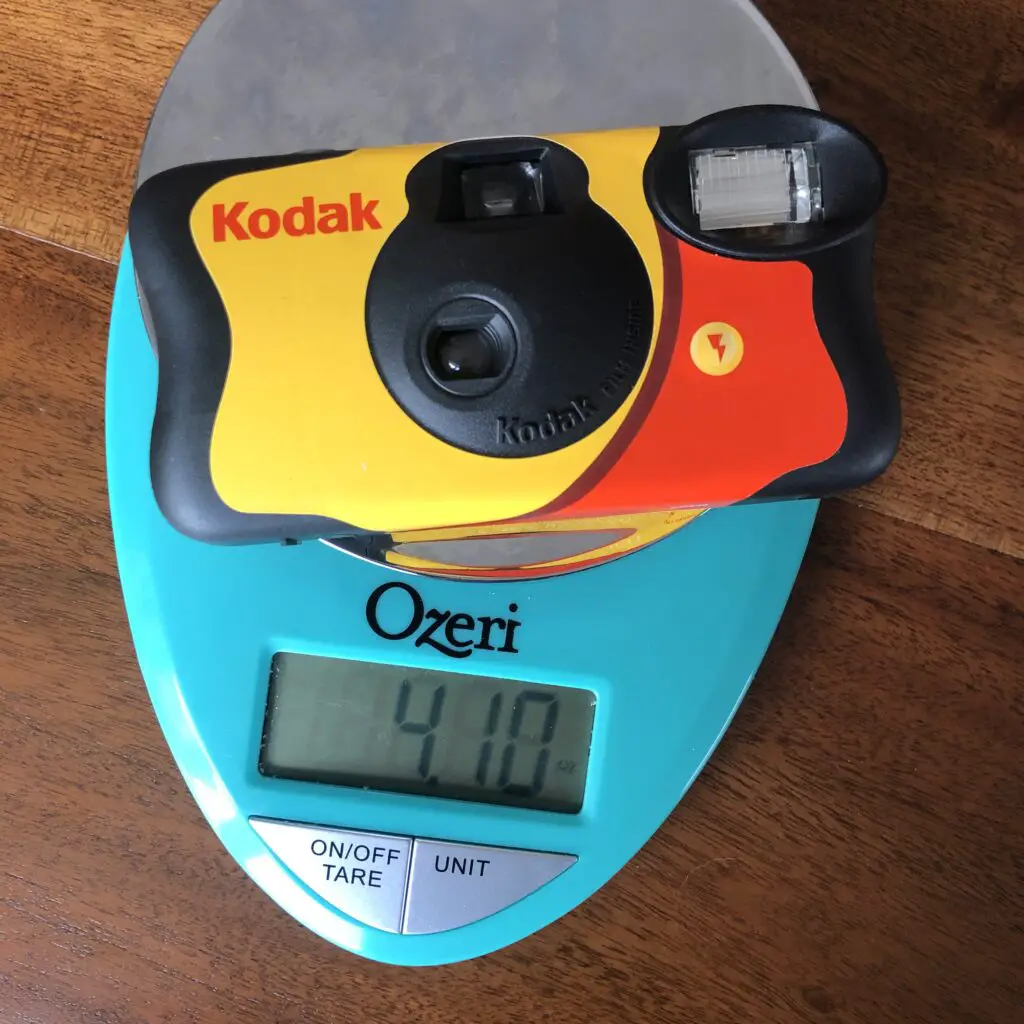
Can You Send Instant Film in the Mail?
Yes, you can send instant film made by Polaroid and Instax through the mail. You can do this in two ways: a single instant film without an envelope and one or multiple instant film sheets in an envelope.
Option 1: Mailing A Single Instant Film Without An Envelope
You may not know this is possible but you can ship your Instax or Polaroid film without an envelope and turn your instant film into a postcard . All you need is a sharpie marker and a stamp. To ship a single sheet of instant film without an envelope, follow these steps:
. All you need is a sharpie marker and a stamp. To ship a single sheet of instant film without an envelope, follow these steps:
- Take a picture using your Polaroid or Instax instant camera (you can use all sizes of instant film
 )
) - Purchase a first class stamp (you can get these at a local post office or grocery store and, at the time of writing, costs $.58 cents)
- Place the stamp on the bottom right of your instant film (on the large white part)
- Using the sharpie, write the address on the lower left of your instant film (next to your stamp)
- If you have a longer message, write it on the on the back of your instant film using your sharpie
- Drop it into any USPS mail box
Option 2: Mailing One or Multiple Instant Film Sheets in an Envelope
To ship one or multiple sheets of instant film, follow these steps:
- Place a sheet of cardboard at the front and back of the photo or stack of photos cut to the size of your film and envelope.
- Tape it together using packaging tape
- Use a padded envelope to protect the film
- For extra protection, you can write “Do Not Bend” on the front of the package
- Ship USPS First Class for the best price if the package is under 13 oz (368.5 g)
Final Thoughts
Mailing film for development may seem like a guessing game, but it doesn’t have to be. The cost of mailing film can range between $4.45 – $7.65 (before tax) to mail between 1 – 10 rolls of 35mm or medium format (120mm) film, or 1 – 2 disposable cameras using USPS First Class Package Service. If mailing 10 or more rolls of 35mm or medium format (120mm) film or more than 2 disposable cameras, than I recommend using USPS priority flat rate mail which costs between $9.45 – $21.50.
As long as the film is packaged correctly, you shouldn’t have any problems when shipping domestically. You also shouldn’t worry about your film getting X-rayed in transit and being ruined. Your film may be scanned if it going to or through a large city. If sending internationally, you might need to think about X-rays damaging your film going through, though if your camera speed is less than 800 the film should be fine. If you are shipping film over 800 ISO, than I recommend using USPS priority mail and telling the post office when it is being mailed. Keeping these tips in mind should help you successfully mail your film without any surprises.
Sources
- https://www.brit.co/how-to-turn-a-polaroid-into-a-postcard/

- https://www.kodak.com/global/en/service/tib/tib5201.shtml

- https://www.richardphotolab.com/blog/post/six-simple-tricks-for-sending-in-your-film

- https://www.tsa.gov/travel/security-screening/whatcanibring/items/film

- https://www.usps.com/ship/mail-shipping-services.htm

- https://www.usps.com/ship/priority-mail.htm#flatrate

- https://lenslurker.com/film-developing-by-mail/

- https://www.pitneybowes.com/us/blog/what-is-the-difference-between-first-class-mail-and-regular-mail.html

